Leading in an Organization: Conflict Management and Leadership Report
VerifiedAdded on 2022/09/28
|19
|5305
|24
Report
AI Summary
This report delves into the multifaceted realm of leadership within organizations, with a particular focus on conflict management and leadership styles. It examines various approaches to problem-solving, emphasizing the importance of communication, decision-making, and creativity. The report uses Steve Jobs as a case study to illustrate effective leadership initiatives, including those that promote cultural diversity and foster team building. It explores the framing of the creative process and the application of different conflict management styles, such as competitive, accommodative, and collaborative approaches. The report also analyzes the significance of organizational vision and culture, leadership empowerment, and the importance of employee relationships in achieving organizational goals. The report concludes by highlighting the key elements of effective leadership, including energy, engagement, and exploration, and their impact on organizational success.
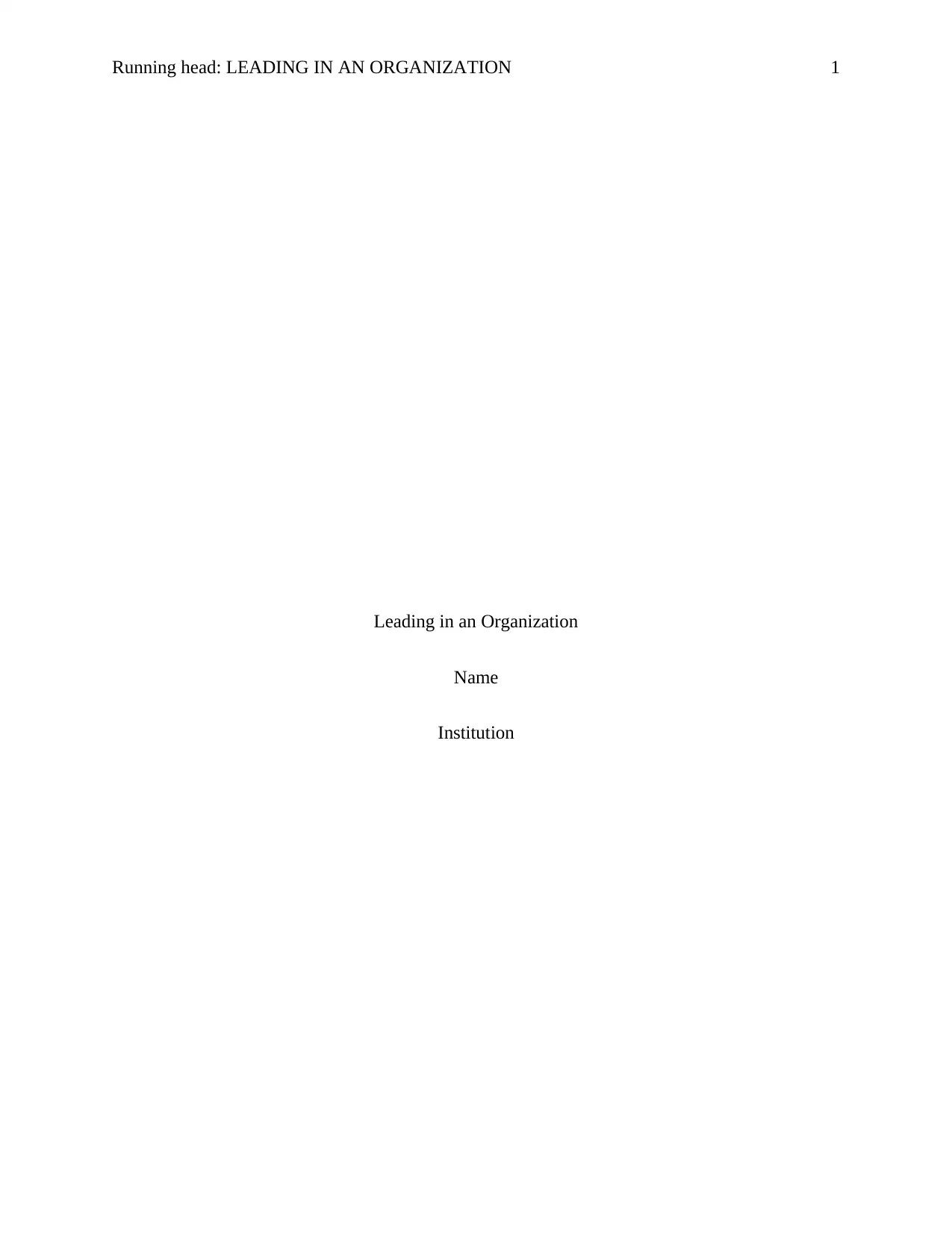
Running head: LEADING IN AN ORGANIZATION 1
Leading in an Organization
Name
Institution
Leading in an Organization
Name
Institution
Paraphrase This Document
Need a fresh take? Get an instant paraphrase of this document with our AI Paraphraser
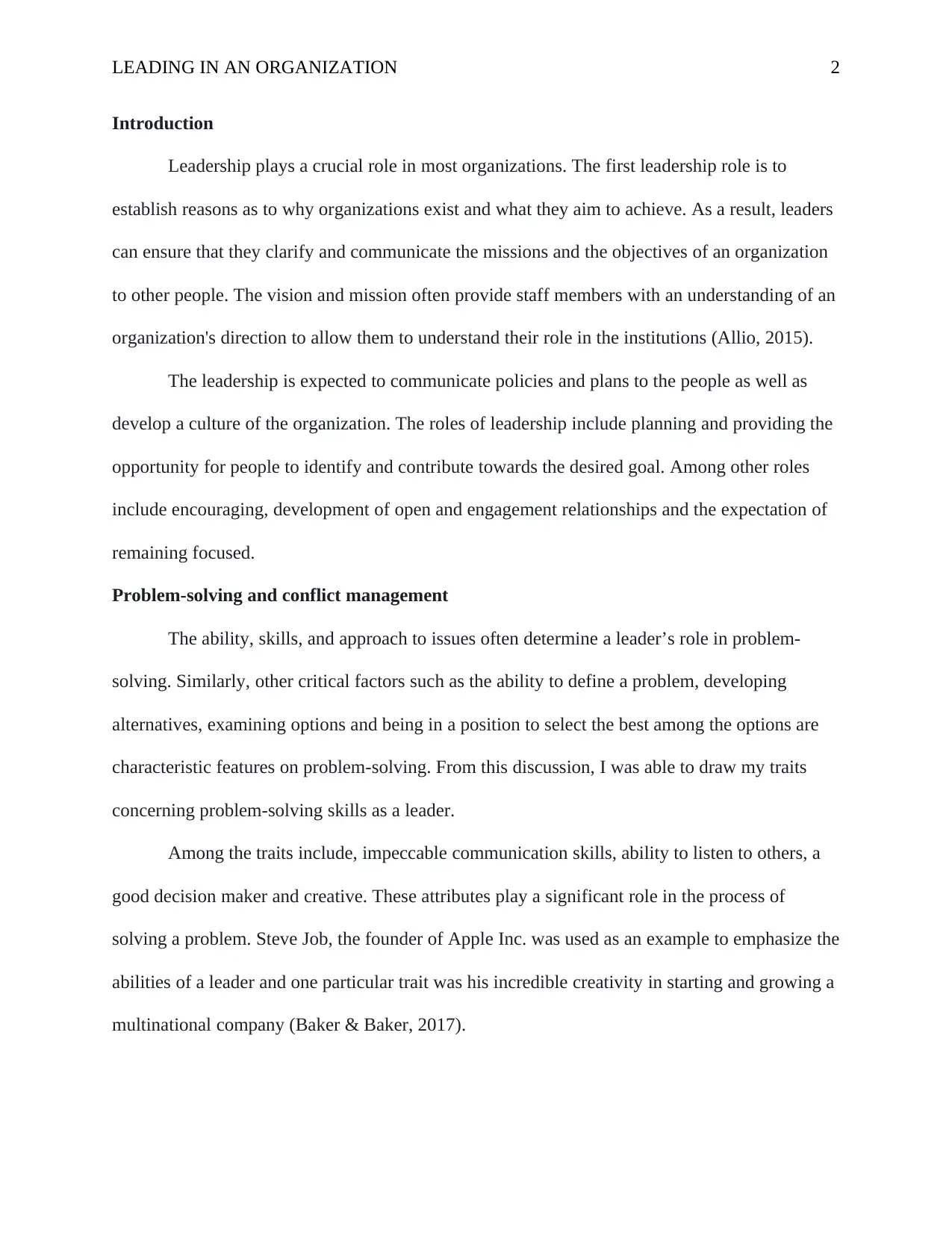
LEADING IN AN ORGANIZATION 2
Introduction
Leadership plays a crucial role in most organizations. The first leadership role is to
establish reasons as to why organizations exist and what they aim to achieve. As a result, leaders
can ensure that they clarify and communicate the missions and the objectives of an organization
to other people. The vision and mission often provide staff members with an understanding of an
organization's direction to allow them to understand their role in the institutions (Allio, 2015).
The leadership is expected to communicate policies and plans to the people as well as
develop a culture of the organization. The roles of leadership include planning and providing the
opportunity for people to identify and contribute towards the desired goal. Among other roles
include encouraging, development of open and engagement relationships and the expectation of
remaining focused.
Problem-solving and conflict management
The ability, skills, and approach to issues often determine a leader’s role in problem-
solving. Similarly, other critical factors such as the ability to define a problem, developing
alternatives, examining options and being in a position to select the best among the options are
characteristic features on problem-solving. From this discussion, I was able to draw my traits
concerning problem-solving skills as a leader.
Among the traits include, impeccable communication skills, ability to listen to others, a
good decision maker and creative. These attributes play a significant role in the process of
solving a problem. Steve Job, the founder of Apple Inc. was used as an example to emphasize the
abilities of a leader and one particular trait was his incredible creativity in starting and growing a
multinational company (Baker & Baker, 2017).
Introduction
Leadership plays a crucial role in most organizations. The first leadership role is to
establish reasons as to why organizations exist and what they aim to achieve. As a result, leaders
can ensure that they clarify and communicate the missions and the objectives of an organization
to other people. The vision and mission often provide staff members with an understanding of an
organization's direction to allow them to understand their role in the institutions (Allio, 2015).
The leadership is expected to communicate policies and plans to the people as well as
develop a culture of the organization. The roles of leadership include planning and providing the
opportunity for people to identify and contribute towards the desired goal. Among other roles
include encouraging, development of open and engagement relationships and the expectation of
remaining focused.
Problem-solving and conflict management
The ability, skills, and approach to issues often determine a leader’s role in problem-
solving. Similarly, other critical factors such as the ability to define a problem, developing
alternatives, examining options and being in a position to select the best among the options are
characteristic features on problem-solving. From this discussion, I was able to draw my traits
concerning problem-solving skills as a leader.
Among the traits include, impeccable communication skills, ability to listen to others, a
good decision maker and creative. These attributes play a significant role in the process of
solving a problem. Steve Job, the founder of Apple Inc. was used as an example to emphasize the
abilities of a leader and one particular trait was his incredible creativity in starting and growing a
multinational company (Baker & Baker, 2017).
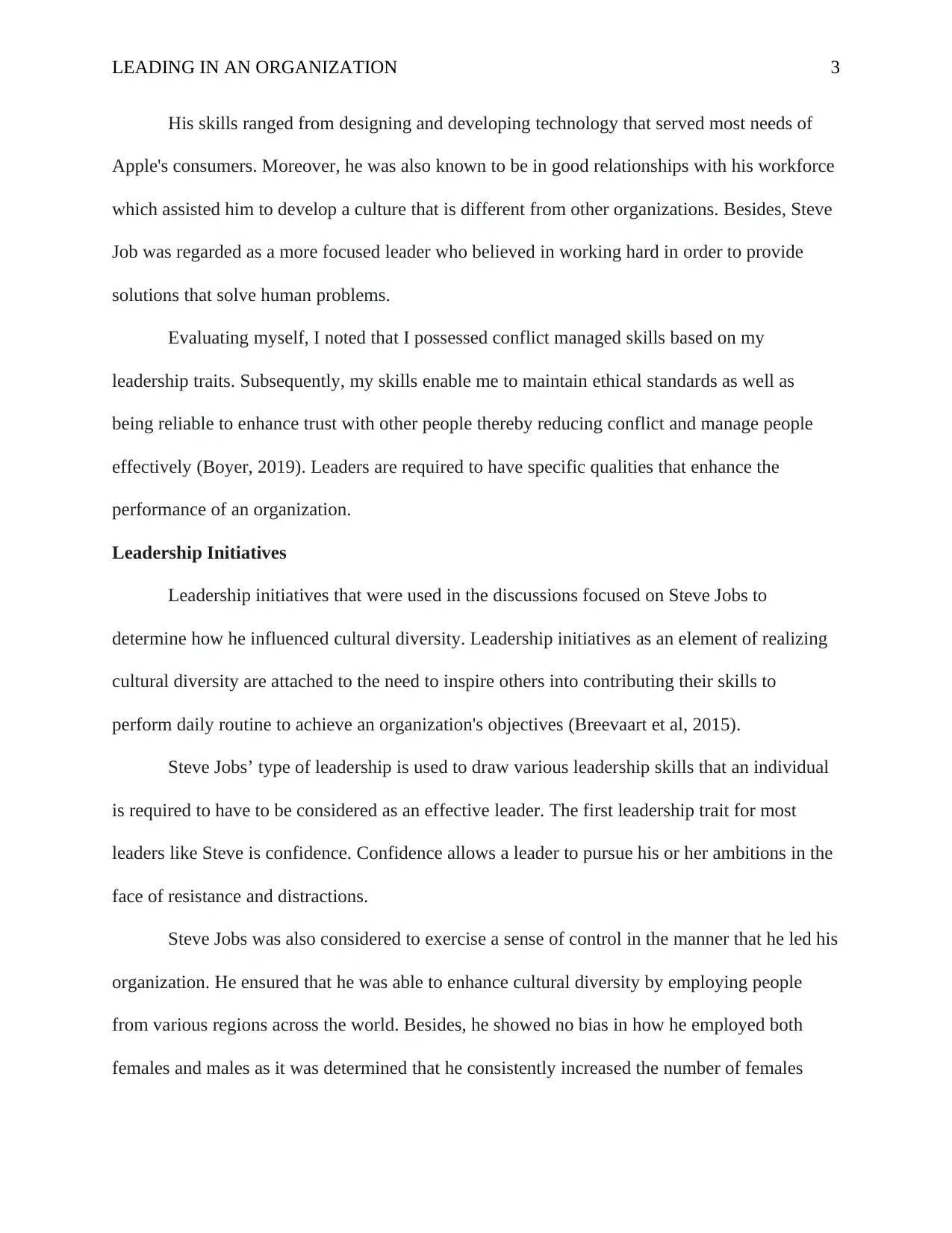
LEADING IN AN ORGANIZATION 3
His skills ranged from designing and developing technology that served most needs of
Apple's consumers. Moreover, he was also known to be in good relationships with his workforce
which assisted him to develop a culture that is different from other organizations. Besides, Steve
Job was regarded as a more focused leader who believed in working hard in order to provide
solutions that solve human problems.
Evaluating myself, I noted that I possessed conflict managed skills based on my
leadership traits. Subsequently, my skills enable me to maintain ethical standards as well as
being reliable to enhance trust with other people thereby reducing conflict and manage people
effectively (Boyer, 2019). Leaders are required to have specific qualities that enhance the
performance of an organization.
Leadership Initiatives
Leadership initiatives that were used in the discussions focused on Steve Jobs to
determine how he influenced cultural diversity. Leadership initiatives as an element of realizing
cultural diversity are attached to the need to inspire others into contributing their skills to
perform daily routine to achieve an organization's objectives (Breevaart et al, 2015).
Steve Jobs’ type of leadership is used to draw various leadership skills that an individual
is required to have to be considered as an effective leader. The first leadership trait for most
leaders like Steve is confidence. Confidence allows a leader to pursue his or her ambitions in the
face of resistance and distractions.
Steve Jobs was also considered to exercise a sense of control in the manner that he led his
organization. He ensured that he was able to enhance cultural diversity by employing people
from various regions across the world. Besides, he showed no bias in how he employed both
females and males as it was determined that he consistently increased the number of females
His skills ranged from designing and developing technology that served most needs of
Apple's consumers. Moreover, he was also known to be in good relationships with his workforce
which assisted him to develop a culture that is different from other organizations. Besides, Steve
Job was regarded as a more focused leader who believed in working hard in order to provide
solutions that solve human problems.
Evaluating myself, I noted that I possessed conflict managed skills based on my
leadership traits. Subsequently, my skills enable me to maintain ethical standards as well as
being reliable to enhance trust with other people thereby reducing conflict and manage people
effectively (Boyer, 2019). Leaders are required to have specific qualities that enhance the
performance of an organization.
Leadership Initiatives
Leadership initiatives that were used in the discussions focused on Steve Jobs to
determine how he influenced cultural diversity. Leadership initiatives as an element of realizing
cultural diversity are attached to the need to inspire others into contributing their skills to
perform daily routine to achieve an organization's objectives (Breevaart et al, 2015).
Steve Jobs’ type of leadership is used to draw various leadership skills that an individual
is required to have to be considered as an effective leader. The first leadership trait for most
leaders like Steve is confidence. Confidence allows a leader to pursue his or her ambitions in the
face of resistance and distractions.
Steve Jobs was also considered to exercise a sense of control in the manner that he led his
organization. He ensured that he was able to enhance cultural diversity by employing people
from various regions across the world. Besides, he showed no bias in how he employed both
females and males as it was determined that he consistently increased the number of females
⊘ This is a preview!⊘
Do you want full access?
Subscribe today to unlock all pages.

Trusted by 1+ million students worldwide
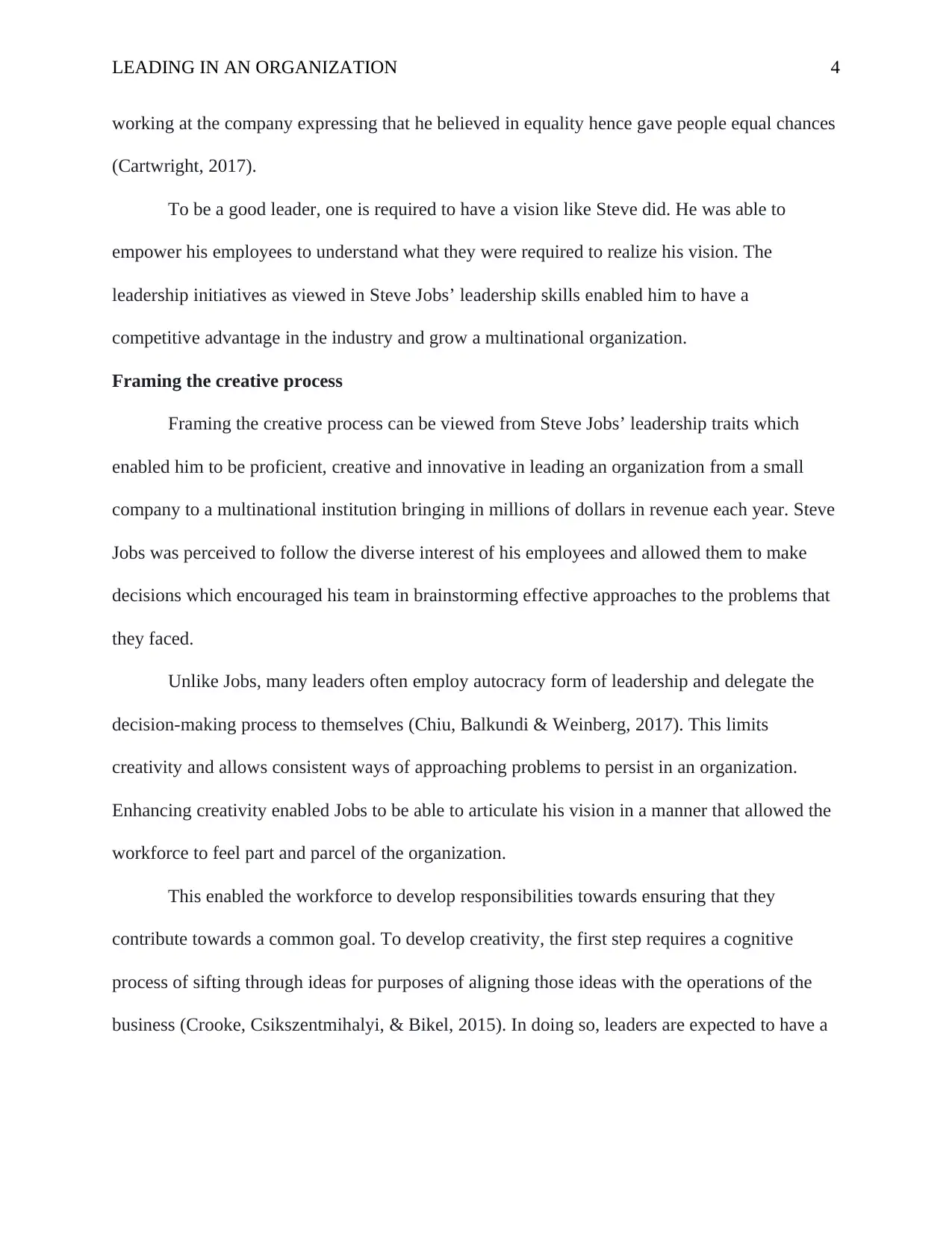
LEADING IN AN ORGANIZATION 4
working at the company expressing that he believed in equality hence gave people equal chances
(Cartwright, 2017).
To be a good leader, one is required to have a vision like Steve did. He was able to
empower his employees to understand what they were required to realize his vision. The
leadership initiatives as viewed in Steve Jobs’ leadership skills enabled him to have a
competitive advantage in the industry and grow a multinational organization.
Framing the creative process
Framing the creative process can be viewed from Steve Jobs’ leadership traits which
enabled him to be proficient, creative and innovative in leading an organization from a small
company to a multinational institution bringing in millions of dollars in revenue each year. Steve
Jobs was perceived to follow the diverse interest of his employees and allowed them to make
decisions which encouraged his team in brainstorming effective approaches to the problems that
they faced.
Unlike Jobs, many leaders often employ autocracy form of leadership and delegate the
decision-making process to themselves (Chiu, Balkundi & Weinberg, 2017). This limits
creativity and allows consistent ways of approaching problems to persist in an organization.
Enhancing creativity enabled Jobs to be able to articulate his vision in a manner that allowed the
workforce to feel part and parcel of the organization.
This enabled the workforce to develop responsibilities towards ensuring that they
contribute towards a common goal. To develop creativity, the first step requires a cognitive
process of sifting through ideas for purposes of aligning those ideas with the operations of the
business (Crooke, Csikszentmihalyi, & Bikel, 2015). In doing so, leaders are expected to have a
working at the company expressing that he believed in equality hence gave people equal chances
(Cartwright, 2017).
To be a good leader, one is required to have a vision like Steve did. He was able to
empower his employees to understand what they were required to realize his vision. The
leadership initiatives as viewed in Steve Jobs’ leadership skills enabled him to have a
competitive advantage in the industry and grow a multinational organization.
Framing the creative process
Framing the creative process can be viewed from Steve Jobs’ leadership traits which
enabled him to be proficient, creative and innovative in leading an organization from a small
company to a multinational institution bringing in millions of dollars in revenue each year. Steve
Jobs was perceived to follow the diverse interest of his employees and allowed them to make
decisions which encouraged his team in brainstorming effective approaches to the problems that
they faced.
Unlike Jobs, many leaders often employ autocracy form of leadership and delegate the
decision-making process to themselves (Chiu, Balkundi & Weinberg, 2017). This limits
creativity and allows consistent ways of approaching problems to persist in an organization.
Enhancing creativity enabled Jobs to be able to articulate his vision in a manner that allowed the
workforce to feel part and parcel of the organization.
This enabled the workforce to develop responsibilities towards ensuring that they
contribute towards a common goal. To develop creativity, the first step requires a cognitive
process of sifting through ideas for purposes of aligning those ideas with the operations of the
business (Crooke, Csikszentmihalyi, & Bikel, 2015). In doing so, leaders are expected to have a
Paraphrase This Document
Need a fresh take? Get an instant paraphrase of this document with our AI Paraphraser
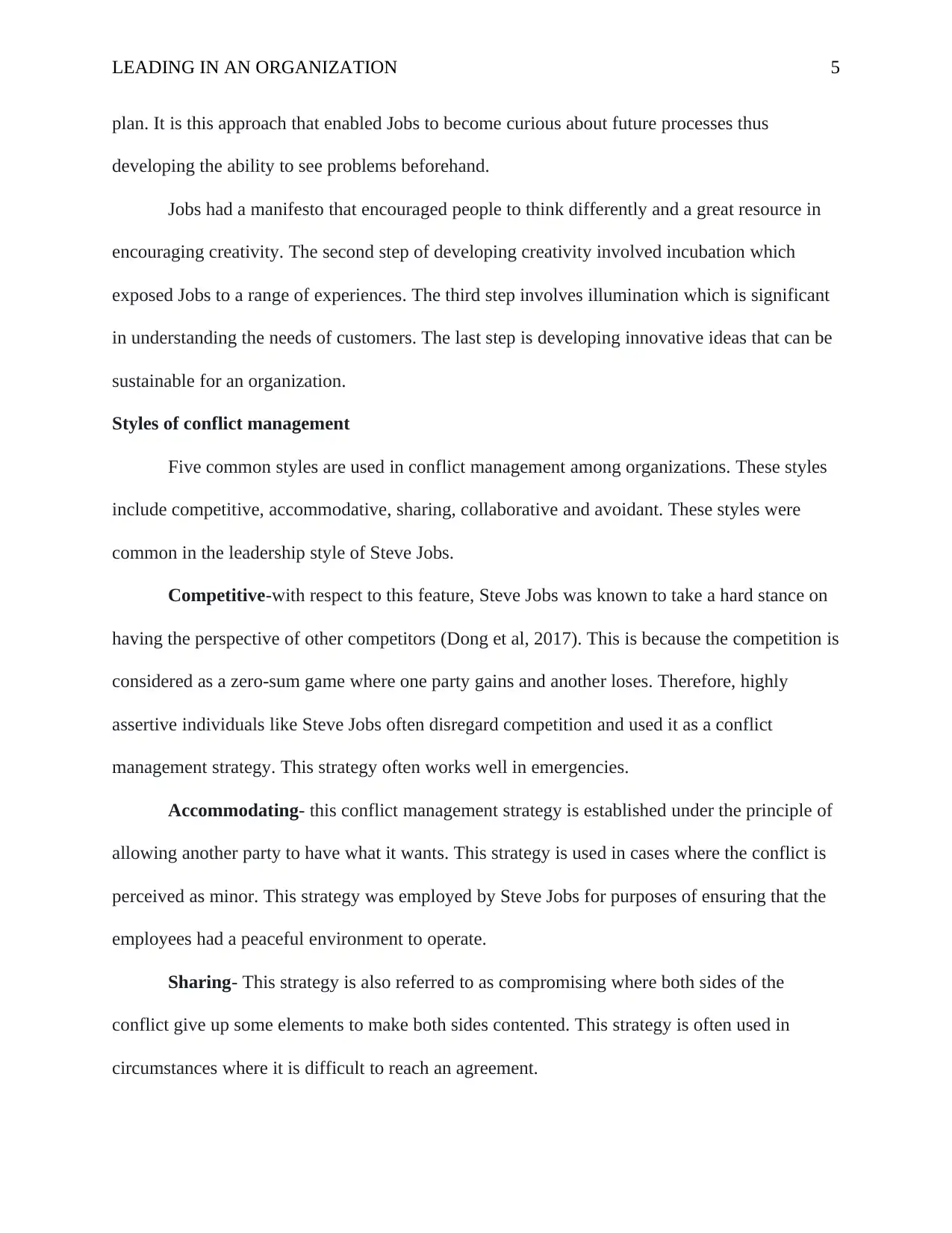
LEADING IN AN ORGANIZATION 5
plan. It is this approach that enabled Jobs to become curious about future processes thus
developing the ability to see problems beforehand.
Jobs had a manifesto that encouraged people to think differently and a great resource in
encouraging creativity. The second step of developing creativity involved incubation which
exposed Jobs to a range of experiences. The third step involves illumination which is significant
in understanding the needs of customers. The last step is developing innovative ideas that can be
sustainable for an organization.
Styles of conflict management
Five common styles are used in conflict management among organizations. These styles
include competitive, accommodative, sharing, collaborative and avoidant. These styles were
common in the leadership style of Steve Jobs.
Competitive-with respect to this feature, Steve Jobs was known to take a hard stance on
having the perspective of other competitors (Dong et al, 2017). This is because the competition is
considered as a zero-sum game where one party gains and another loses. Therefore, highly
assertive individuals like Steve Jobs often disregard competition and used it as a conflict
management strategy. This strategy often works well in emergencies.
Accommodating- this conflict management strategy is established under the principle of
allowing another party to have what it wants. This strategy is used in cases where the conflict is
perceived as minor. This strategy was employed by Steve Jobs for purposes of ensuring that the
employees had a peaceful environment to operate.
Sharing- This strategy is also referred to as compromising where both sides of the
conflict give up some elements to make both sides contented. This strategy is often used in
circumstances where it is difficult to reach an agreement.
plan. It is this approach that enabled Jobs to become curious about future processes thus
developing the ability to see problems beforehand.
Jobs had a manifesto that encouraged people to think differently and a great resource in
encouraging creativity. The second step of developing creativity involved incubation which
exposed Jobs to a range of experiences. The third step involves illumination which is significant
in understanding the needs of customers. The last step is developing innovative ideas that can be
sustainable for an organization.
Styles of conflict management
Five common styles are used in conflict management among organizations. These styles
include competitive, accommodative, sharing, collaborative and avoidant. These styles were
common in the leadership style of Steve Jobs.
Competitive-with respect to this feature, Steve Jobs was known to take a hard stance on
having the perspective of other competitors (Dong et al, 2017). This is because the competition is
considered as a zero-sum game where one party gains and another loses. Therefore, highly
assertive individuals like Steve Jobs often disregard competition and used it as a conflict
management strategy. This strategy often works well in emergencies.
Accommodating- this conflict management strategy is established under the principle of
allowing another party to have what it wants. This strategy is used in cases where the conflict is
perceived as minor. This strategy was employed by Steve Jobs for purposes of ensuring that the
employees had a peaceful environment to operate.
Sharing- This strategy is also referred to as compromising where both sides of the
conflict give up some elements to make both sides contented. This strategy is often used in
circumstances where it is difficult to reach an agreement.
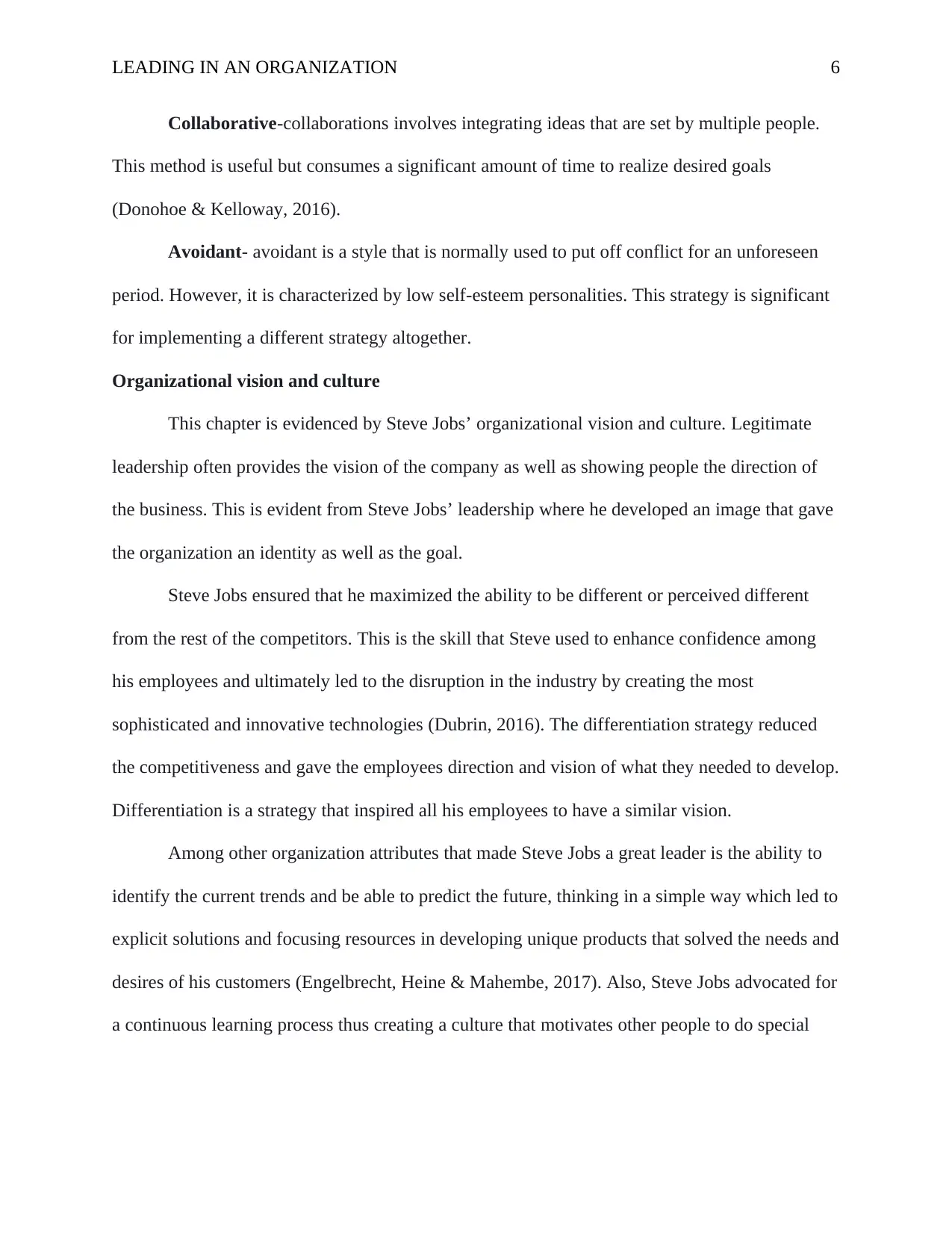
LEADING IN AN ORGANIZATION 6
Collaborative-collaborations involves integrating ideas that are set by multiple people.
This method is useful but consumes a significant amount of time to realize desired goals
(Donohoe & Kelloway, 2016).
Avoidant- avoidant is a style that is normally used to put off conflict for an unforeseen
period. However, it is characterized by low self-esteem personalities. This strategy is significant
for implementing a different strategy altogether.
Organizational vision and culture
This chapter is evidenced by Steve Jobs’ organizational vision and culture. Legitimate
leadership often provides the vision of the company as well as showing people the direction of
the business. This is evident from Steve Jobs’ leadership where he developed an image that gave
the organization an identity as well as the goal.
Steve Jobs ensured that he maximized the ability to be different or perceived different
from the rest of the competitors. This is the skill that Steve used to enhance confidence among
his employees and ultimately led to the disruption in the industry by creating the most
sophisticated and innovative technologies (Dubrin, 2016). The differentiation strategy reduced
the competitiveness and gave the employees direction and vision of what they needed to develop.
Differentiation is a strategy that inspired all his employees to have a similar vision.
Among other organization attributes that made Steve Jobs a great leader is the ability to
identify the current trends and be able to predict the future, thinking in a simple way which led to
explicit solutions and focusing resources in developing unique products that solved the needs and
desires of his customers (Engelbrecht, Heine & Mahembe, 2017). Also, Steve Jobs advocated for
a continuous learning process thus creating a culture that motivates other people to do special
Collaborative-collaborations involves integrating ideas that are set by multiple people.
This method is useful but consumes a significant amount of time to realize desired goals
(Donohoe & Kelloway, 2016).
Avoidant- avoidant is a style that is normally used to put off conflict for an unforeseen
period. However, it is characterized by low self-esteem personalities. This strategy is significant
for implementing a different strategy altogether.
Organizational vision and culture
This chapter is evidenced by Steve Jobs’ organizational vision and culture. Legitimate
leadership often provides the vision of the company as well as showing people the direction of
the business. This is evident from Steve Jobs’ leadership where he developed an image that gave
the organization an identity as well as the goal.
Steve Jobs ensured that he maximized the ability to be different or perceived different
from the rest of the competitors. This is the skill that Steve used to enhance confidence among
his employees and ultimately led to the disruption in the industry by creating the most
sophisticated and innovative technologies (Dubrin, 2016). The differentiation strategy reduced
the competitiveness and gave the employees direction and vision of what they needed to develop.
Differentiation is a strategy that inspired all his employees to have a similar vision.
Among other organization attributes that made Steve Jobs a great leader is the ability to
identify the current trends and be able to predict the future, thinking in a simple way which led to
explicit solutions and focusing resources in developing unique products that solved the needs and
desires of his customers (Engelbrecht, Heine & Mahembe, 2017). Also, Steve Jobs advocated for
a continuous learning process thus creating a culture that motivates other people to do special
⊘ This is a preview!⊘
Do you want full access?
Subscribe today to unlock all pages.

Trusted by 1+ million students worldwide
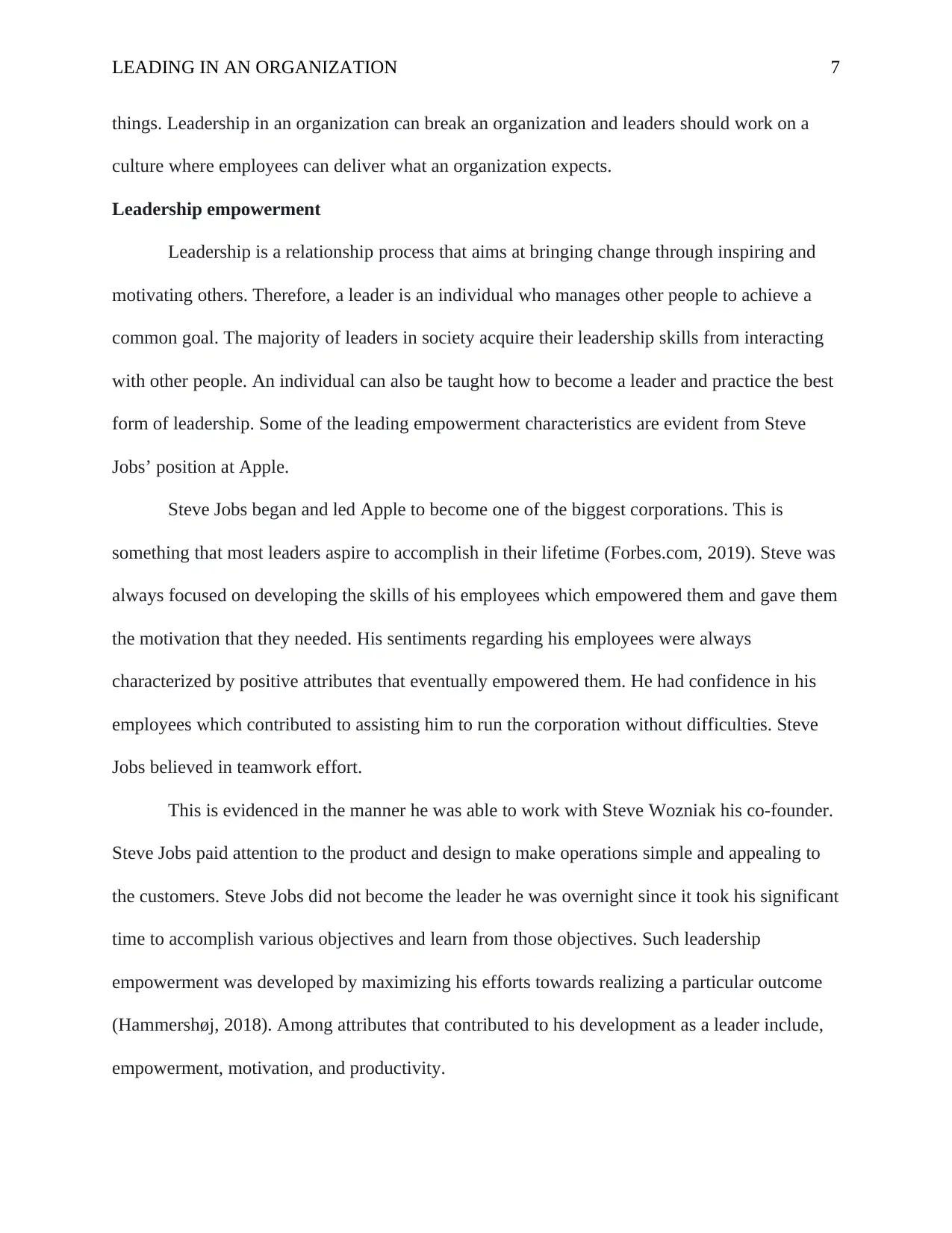
LEADING IN AN ORGANIZATION 7
things. Leadership in an organization can break an organization and leaders should work on a
culture where employees can deliver what an organization expects.
Leadership empowerment
Leadership is a relationship process that aims at bringing change through inspiring and
motivating others. Therefore, a leader is an individual who manages other people to achieve a
common goal. The majority of leaders in society acquire their leadership skills from interacting
with other people. An individual can also be taught how to become a leader and practice the best
form of leadership. Some of the leading empowerment characteristics are evident from Steve
Jobs’ position at Apple.
Steve Jobs began and led Apple to become one of the biggest corporations. This is
something that most leaders aspire to accomplish in their lifetime (Forbes.com, 2019). Steve was
always focused on developing the skills of his employees which empowered them and gave them
the motivation that they needed. His sentiments regarding his employees were always
characterized by positive attributes that eventually empowered them. He had confidence in his
employees which contributed to assisting him to run the corporation without difficulties. Steve
Jobs believed in teamwork effort.
This is evidenced in the manner he was able to work with Steve Wozniak his co-founder.
Steve Jobs paid attention to the product and design to make operations simple and appealing to
the customers. Steve Jobs did not become the leader he was overnight since it took his significant
time to accomplish various objectives and learn from those objectives. Such leadership
empowerment was developed by maximizing his efforts towards realizing a particular outcome
(Hammershøj, 2018). Among attributes that contributed to his development as a leader include,
empowerment, motivation, and productivity.
things. Leadership in an organization can break an organization and leaders should work on a
culture where employees can deliver what an organization expects.
Leadership empowerment
Leadership is a relationship process that aims at bringing change through inspiring and
motivating others. Therefore, a leader is an individual who manages other people to achieve a
common goal. The majority of leaders in society acquire their leadership skills from interacting
with other people. An individual can also be taught how to become a leader and practice the best
form of leadership. Some of the leading empowerment characteristics are evident from Steve
Jobs’ position at Apple.
Steve Jobs began and led Apple to become one of the biggest corporations. This is
something that most leaders aspire to accomplish in their lifetime (Forbes.com, 2019). Steve was
always focused on developing the skills of his employees which empowered them and gave them
the motivation that they needed. His sentiments regarding his employees were always
characterized by positive attributes that eventually empowered them. He had confidence in his
employees which contributed to assisting him to run the corporation without difficulties. Steve
Jobs believed in teamwork effort.
This is evidenced in the manner he was able to work with Steve Wozniak his co-founder.
Steve Jobs paid attention to the product and design to make operations simple and appealing to
the customers. Steve Jobs did not become the leader he was overnight since it took his significant
time to accomplish various objectives and learn from those objectives. Such leadership
empowerment was developed by maximizing his efforts towards realizing a particular outcome
(Hammershøj, 2018). Among attributes that contributed to his development as a leader include,
empowerment, motivation, and productivity.
Paraphrase This Document
Need a fresh take? Get an instant paraphrase of this document with our AI Paraphraser
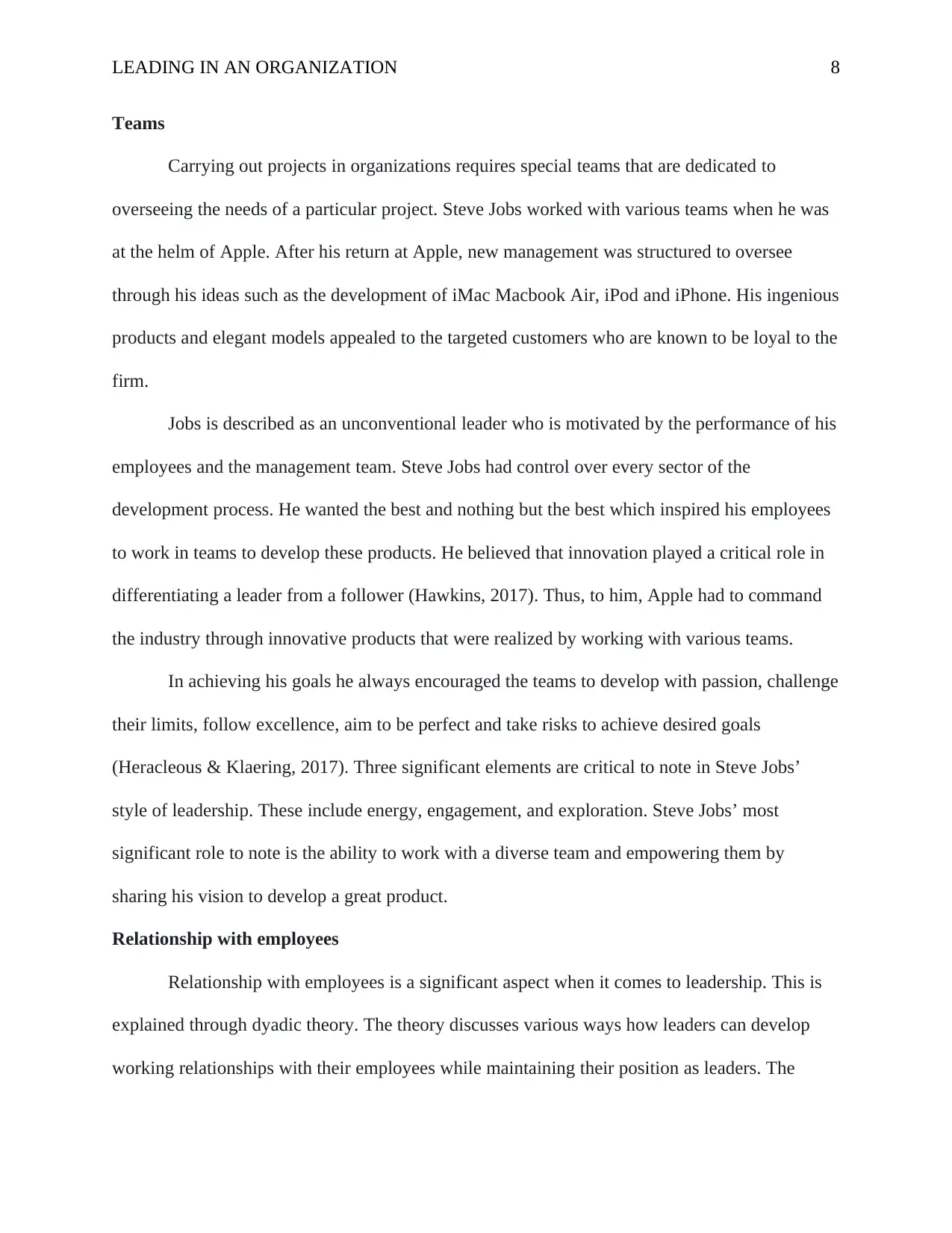
LEADING IN AN ORGANIZATION 8
Teams
Carrying out projects in organizations requires special teams that are dedicated to
overseeing the needs of a particular project. Steve Jobs worked with various teams when he was
at the helm of Apple. After his return at Apple, new management was structured to oversee
through his ideas such as the development of iMac Macbook Air, iPod and iPhone. His ingenious
products and elegant models appealed to the targeted customers who are known to be loyal to the
firm.
Jobs is described as an unconventional leader who is motivated by the performance of his
employees and the management team. Steve Jobs had control over every sector of the
development process. He wanted the best and nothing but the best which inspired his employees
to work in teams to develop these products. He believed that innovation played a critical role in
differentiating a leader from a follower (Hawkins, 2017). Thus, to him, Apple had to command
the industry through innovative products that were realized by working with various teams.
In achieving his goals he always encouraged the teams to develop with passion, challenge
their limits, follow excellence, aim to be perfect and take risks to achieve desired goals
(Heracleous & Klaering, 2017). Three significant elements are critical to note in Steve Jobs’
style of leadership. These include energy, engagement, and exploration. Steve Jobs’ most
significant role to note is the ability to work with a diverse team and empowering them by
sharing his vision to develop a great product.
Relationship with employees
Relationship with employees is a significant aspect when it comes to leadership. This is
explained through dyadic theory. The theory discusses various ways how leaders can develop
working relationships with their employees while maintaining their position as leaders. The
Teams
Carrying out projects in organizations requires special teams that are dedicated to
overseeing the needs of a particular project. Steve Jobs worked with various teams when he was
at the helm of Apple. After his return at Apple, new management was structured to oversee
through his ideas such as the development of iMac Macbook Air, iPod and iPhone. His ingenious
products and elegant models appealed to the targeted customers who are known to be loyal to the
firm.
Jobs is described as an unconventional leader who is motivated by the performance of his
employees and the management team. Steve Jobs had control over every sector of the
development process. He wanted the best and nothing but the best which inspired his employees
to work in teams to develop these products. He believed that innovation played a critical role in
differentiating a leader from a follower (Hawkins, 2017). Thus, to him, Apple had to command
the industry through innovative products that were realized by working with various teams.
In achieving his goals he always encouraged the teams to develop with passion, challenge
their limits, follow excellence, aim to be perfect and take risks to achieve desired goals
(Heracleous & Klaering, 2017). Three significant elements are critical to note in Steve Jobs’
style of leadership. These include energy, engagement, and exploration. Steve Jobs’ most
significant role to note is the ability to work with a diverse team and empowering them by
sharing his vision to develop a great product.
Relationship with employees
Relationship with employees is a significant aspect when it comes to leadership. This is
explained through dyadic theory. The theory discusses various ways how leaders can develop
working relationships with their employees while maintaining their position as leaders. The
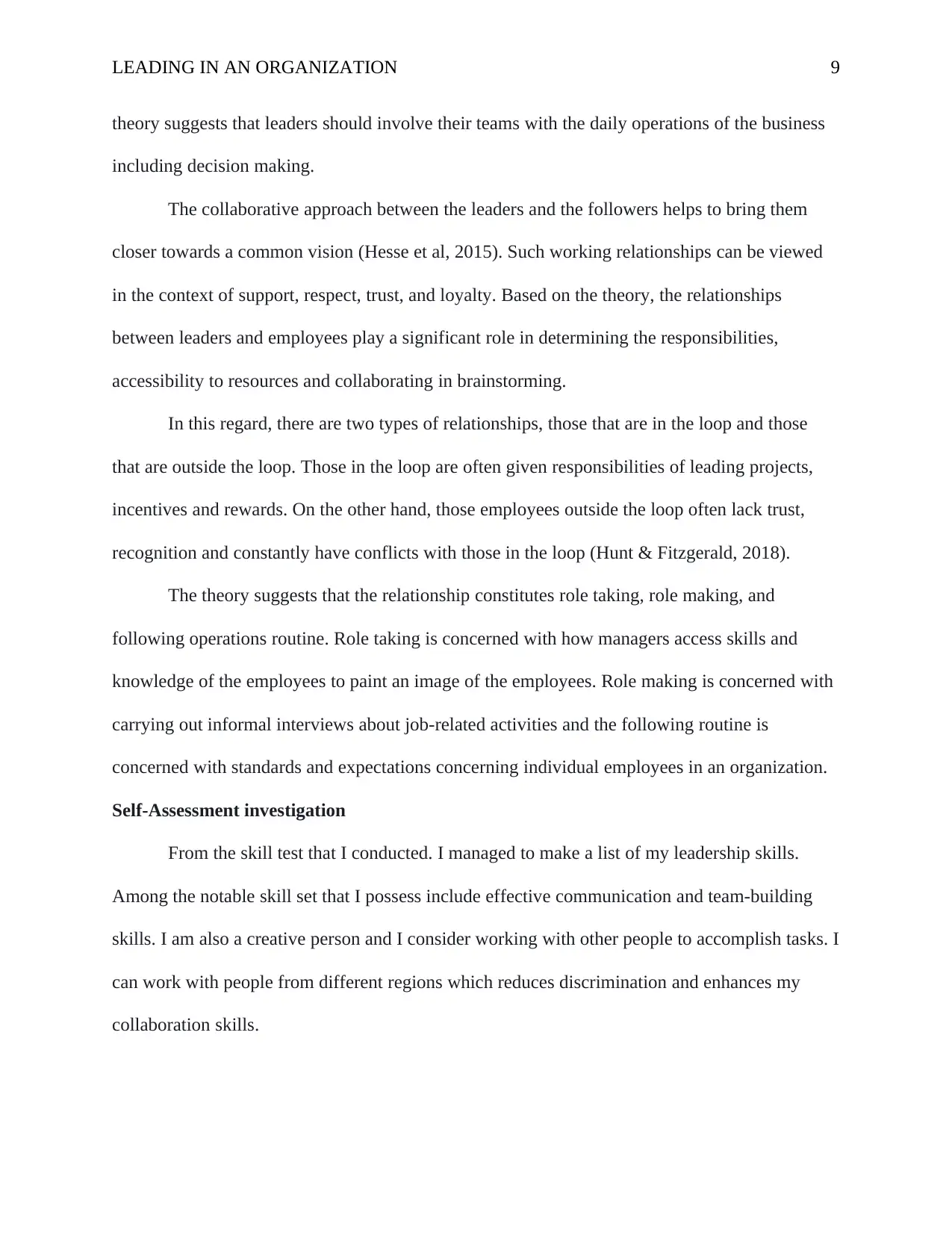
LEADING IN AN ORGANIZATION 9
theory suggests that leaders should involve their teams with the daily operations of the business
including decision making.
The collaborative approach between the leaders and the followers helps to bring them
closer towards a common vision (Hesse et al, 2015). Such working relationships can be viewed
in the context of support, respect, trust, and loyalty. Based on the theory, the relationships
between leaders and employees play a significant role in determining the responsibilities,
accessibility to resources and collaborating in brainstorming.
In this regard, there are two types of relationships, those that are in the loop and those
that are outside the loop. Those in the loop are often given responsibilities of leading projects,
incentives and rewards. On the other hand, those employees outside the loop often lack trust,
recognition and constantly have conflicts with those in the loop (Hunt & Fitzgerald, 2018).
The theory suggests that the relationship constitutes role taking, role making, and
following operations routine. Role taking is concerned with how managers access skills and
knowledge of the employees to paint an image of the employees. Role making is concerned with
carrying out informal interviews about job-related activities and the following routine is
concerned with standards and expectations concerning individual employees in an organization.
Self-Assessment investigation
From the skill test that I conducted. I managed to make a list of my leadership skills.
Among the notable skill set that I possess include effective communication and team-building
skills. I am also a creative person and I consider working with other people to accomplish tasks. I
can work with people from different regions which reduces discrimination and enhances my
collaboration skills.
theory suggests that leaders should involve their teams with the daily operations of the business
including decision making.
The collaborative approach between the leaders and the followers helps to bring them
closer towards a common vision (Hesse et al, 2015). Such working relationships can be viewed
in the context of support, respect, trust, and loyalty. Based on the theory, the relationships
between leaders and employees play a significant role in determining the responsibilities,
accessibility to resources and collaborating in brainstorming.
In this regard, there are two types of relationships, those that are in the loop and those
that are outside the loop. Those in the loop are often given responsibilities of leading projects,
incentives and rewards. On the other hand, those employees outside the loop often lack trust,
recognition and constantly have conflicts with those in the loop (Hunt & Fitzgerald, 2018).
The theory suggests that the relationship constitutes role taking, role making, and
following operations routine. Role taking is concerned with how managers access skills and
knowledge of the employees to paint an image of the employees. Role making is concerned with
carrying out informal interviews about job-related activities and the following routine is
concerned with standards and expectations concerning individual employees in an organization.
Self-Assessment investigation
From the skill test that I conducted. I managed to make a list of my leadership skills.
Among the notable skill set that I possess include effective communication and team-building
skills. I am also a creative person and I consider working with other people to accomplish tasks. I
can work with people from different regions which reduces discrimination and enhances my
collaboration skills.
⊘ This is a preview!⊘
Do you want full access?
Subscribe today to unlock all pages.

Trusted by 1+ million students worldwide
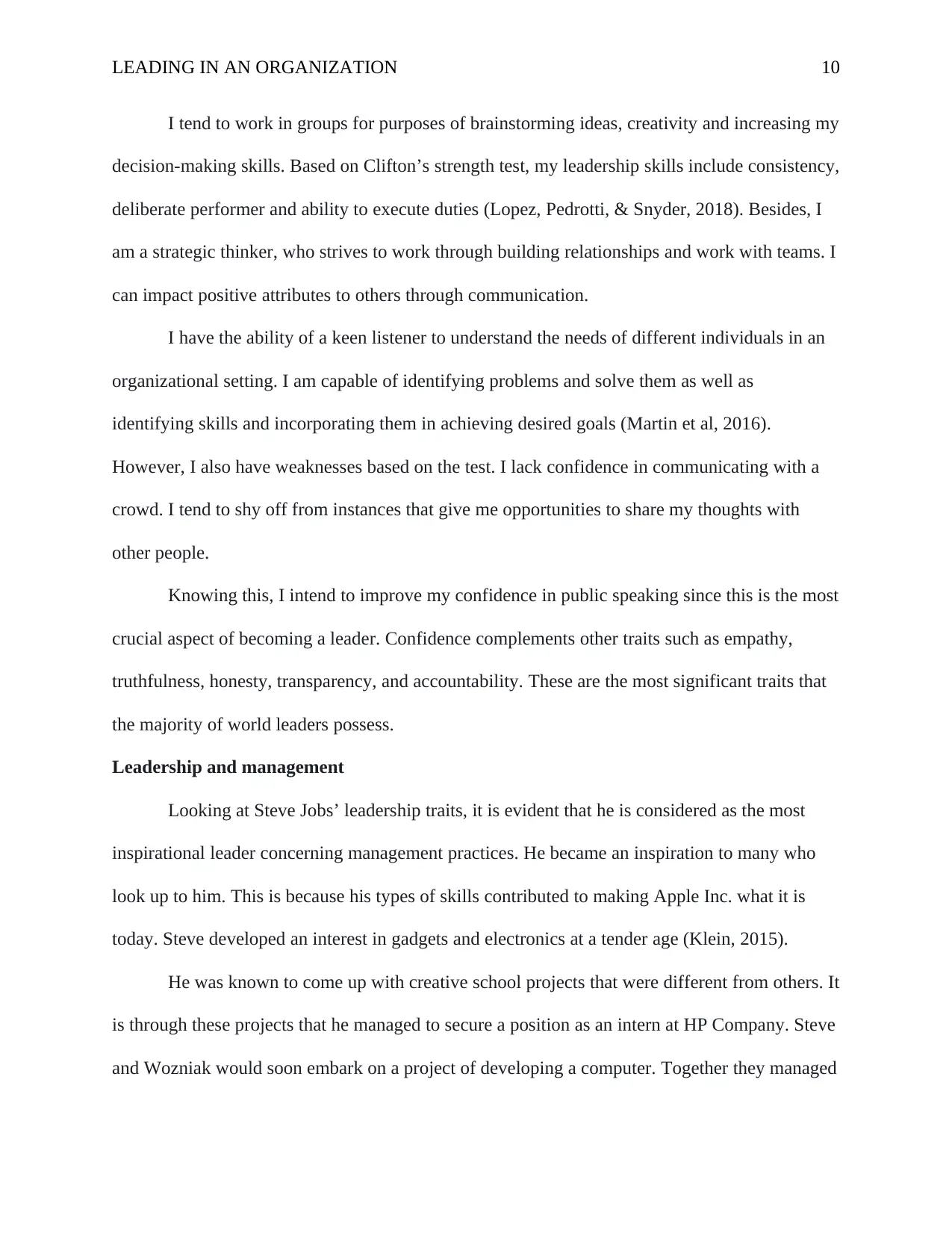
LEADING IN AN ORGANIZATION 10
I tend to work in groups for purposes of brainstorming ideas, creativity and increasing my
decision-making skills. Based on Clifton’s strength test, my leadership skills include consistency,
deliberate performer and ability to execute duties (Lopez, Pedrotti, & Snyder, 2018). Besides, I
am a strategic thinker, who strives to work through building relationships and work with teams. I
can impact positive attributes to others through communication.
I have the ability of a keen listener to understand the needs of different individuals in an
organizational setting. I am capable of identifying problems and solve them as well as
identifying skills and incorporating them in achieving desired goals (Martin et al, 2016).
However, I also have weaknesses based on the test. I lack confidence in communicating with a
crowd. I tend to shy off from instances that give me opportunities to share my thoughts with
other people.
Knowing this, I intend to improve my confidence in public speaking since this is the most
crucial aspect of becoming a leader. Confidence complements other traits such as empathy,
truthfulness, honesty, transparency, and accountability. These are the most significant traits that
the majority of world leaders possess.
Leadership and management
Looking at Steve Jobs’ leadership traits, it is evident that he is considered as the most
inspirational leader concerning management practices. He became an inspiration to many who
look up to him. This is because his types of skills contributed to making Apple Inc. what it is
today. Steve developed an interest in gadgets and electronics at a tender age (Klein, 2015).
He was known to come up with creative school projects that were different from others. It
is through these projects that he managed to secure a position as an intern at HP Company. Steve
and Wozniak would soon embark on a project of developing a computer. Together they managed
I tend to work in groups for purposes of brainstorming ideas, creativity and increasing my
decision-making skills. Based on Clifton’s strength test, my leadership skills include consistency,
deliberate performer and ability to execute duties (Lopez, Pedrotti, & Snyder, 2018). Besides, I
am a strategic thinker, who strives to work through building relationships and work with teams. I
can impact positive attributes to others through communication.
I have the ability of a keen listener to understand the needs of different individuals in an
organizational setting. I am capable of identifying problems and solve them as well as
identifying skills and incorporating them in achieving desired goals (Martin et al, 2016).
However, I also have weaknesses based on the test. I lack confidence in communicating with a
crowd. I tend to shy off from instances that give me opportunities to share my thoughts with
other people.
Knowing this, I intend to improve my confidence in public speaking since this is the most
crucial aspect of becoming a leader. Confidence complements other traits such as empathy,
truthfulness, honesty, transparency, and accountability. These are the most significant traits that
the majority of world leaders possess.
Leadership and management
Looking at Steve Jobs’ leadership traits, it is evident that he is considered as the most
inspirational leader concerning management practices. He became an inspiration to many who
look up to him. This is because his types of skills contributed to making Apple Inc. what it is
today. Steve developed an interest in gadgets and electronics at a tender age (Klein, 2015).
He was known to come up with creative school projects that were different from others. It
is through these projects that he managed to secure a position as an intern at HP Company. Steve
and Wozniak would soon embark on a project of developing a computer. Together they managed
Paraphrase This Document
Need a fresh take? Get an instant paraphrase of this document with our AI Paraphraser
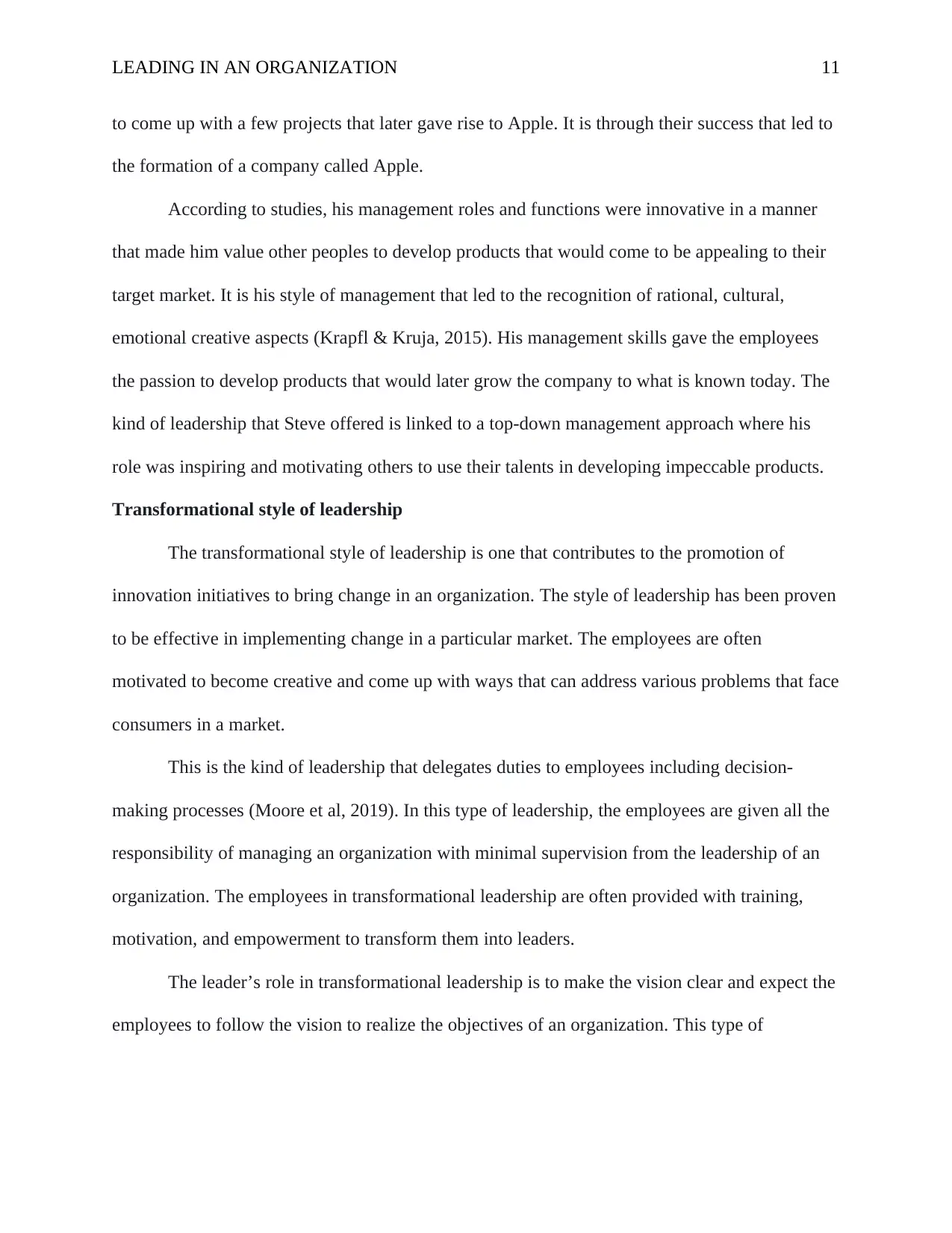
LEADING IN AN ORGANIZATION 11
to come up with a few projects that later gave rise to Apple. It is through their success that led to
the formation of a company called Apple.
According to studies, his management roles and functions were innovative in a manner
that made him value other peoples to develop products that would come to be appealing to their
target market. It is his style of management that led to the recognition of rational, cultural,
emotional creative aspects (Krapfl & Kruja, 2015). His management skills gave the employees
the passion to develop products that would later grow the company to what is known today. The
kind of leadership that Steve offered is linked to a top-down management approach where his
role was inspiring and motivating others to use their talents in developing impeccable products.
Transformational style of leadership
The transformational style of leadership is one that contributes to the promotion of
innovation initiatives to bring change in an organization. The style of leadership has been proven
to be effective in implementing change in a particular market. The employees are often
motivated to become creative and come up with ways that can address various problems that face
consumers in a market.
This is the kind of leadership that delegates duties to employees including decision-
making processes (Moore et al, 2019). In this type of leadership, the employees are given all the
responsibility of managing an organization with minimal supervision from the leadership of an
organization. The employees in transformational leadership are often provided with training,
motivation, and empowerment to transform them into leaders.
The leader’s role in transformational leadership is to make the vision clear and expect the
employees to follow the vision to realize the objectives of an organization. This type of
to come up with a few projects that later gave rise to Apple. It is through their success that led to
the formation of a company called Apple.
According to studies, his management roles and functions were innovative in a manner
that made him value other peoples to develop products that would come to be appealing to their
target market. It is his style of management that led to the recognition of rational, cultural,
emotional creative aspects (Krapfl & Kruja, 2015). His management skills gave the employees
the passion to develop products that would later grow the company to what is known today. The
kind of leadership that Steve offered is linked to a top-down management approach where his
role was inspiring and motivating others to use their talents in developing impeccable products.
Transformational style of leadership
The transformational style of leadership is one that contributes to the promotion of
innovation initiatives to bring change in an organization. The style of leadership has been proven
to be effective in implementing change in a particular market. The employees are often
motivated to become creative and come up with ways that can address various problems that face
consumers in a market.
This is the kind of leadership that delegates duties to employees including decision-
making processes (Moore et al, 2019). In this type of leadership, the employees are given all the
responsibility of managing an organization with minimal supervision from the leadership of an
organization. The employees in transformational leadership are often provided with training,
motivation, and empowerment to transform them into leaders.
The leader’s role in transformational leadership is to make the vision clear and expect the
employees to follow the vision to realize the objectives of an organization. This type of
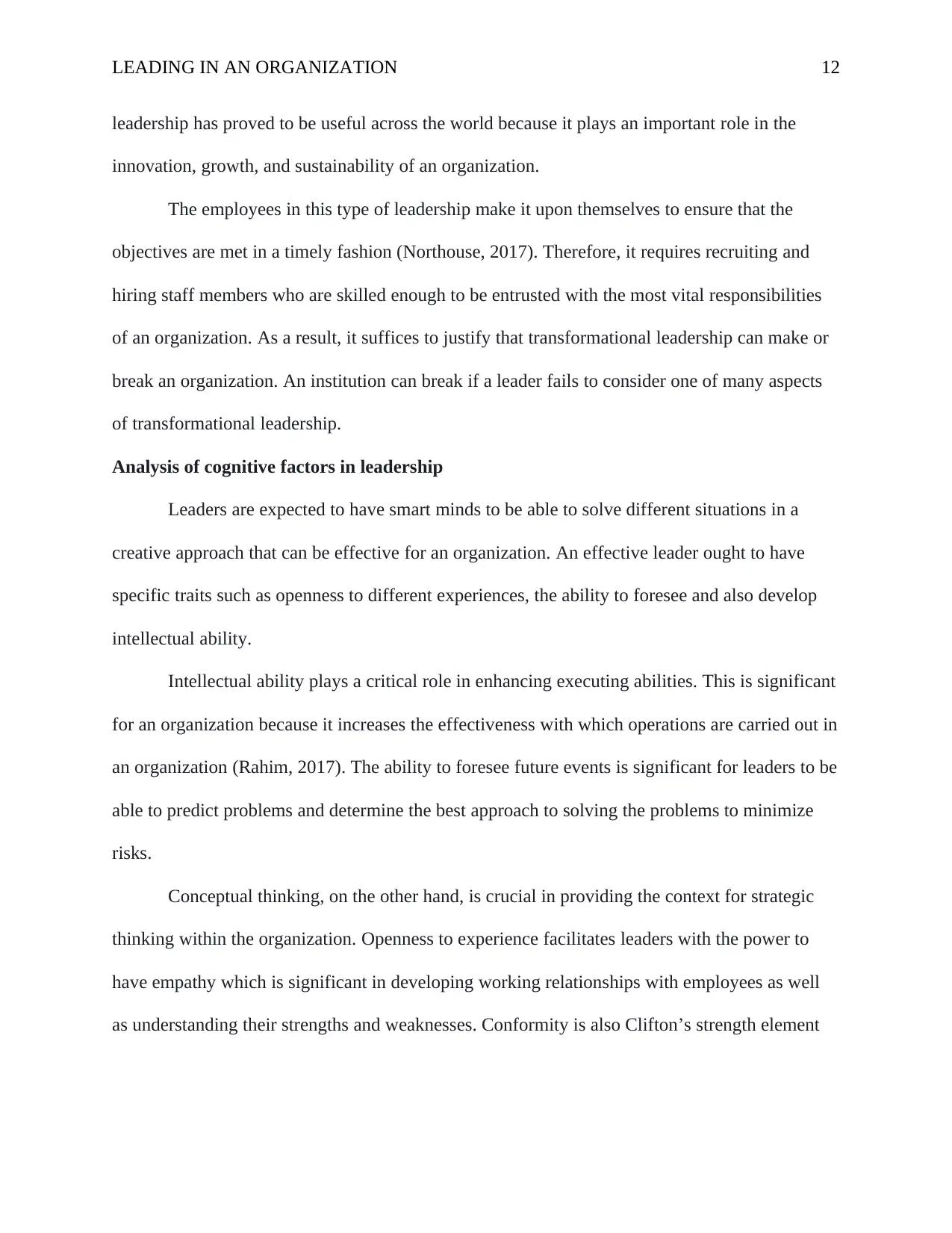
LEADING IN AN ORGANIZATION 12
leadership has proved to be useful across the world because it plays an important role in the
innovation, growth, and sustainability of an organization.
The employees in this type of leadership make it upon themselves to ensure that the
objectives are met in a timely fashion (Northouse, 2017). Therefore, it requires recruiting and
hiring staff members who are skilled enough to be entrusted with the most vital responsibilities
of an organization. As a result, it suffices to justify that transformational leadership can make or
break an organization. An institution can break if a leader fails to consider one of many aspects
of transformational leadership.
Analysis of cognitive factors in leadership
Leaders are expected to have smart minds to be able to solve different situations in a
creative approach that can be effective for an organization. An effective leader ought to have
specific traits such as openness to different experiences, the ability to foresee and also develop
intellectual ability.
Intellectual ability plays a critical role in enhancing executing abilities. This is significant
for an organization because it increases the effectiveness with which operations are carried out in
an organization (Rahim, 2017). The ability to foresee future events is significant for leaders to be
able to predict problems and determine the best approach to solving the problems to minimize
risks.
Conceptual thinking, on the other hand, is crucial in providing the context for strategic
thinking within the organization. Openness to experience facilitates leaders with the power to
have empathy which is significant in developing working relationships with employees as well
as understanding their strengths and weaknesses. Conformity is also Clifton’s strength element
leadership has proved to be useful across the world because it plays an important role in the
innovation, growth, and sustainability of an organization.
The employees in this type of leadership make it upon themselves to ensure that the
objectives are met in a timely fashion (Northouse, 2017). Therefore, it requires recruiting and
hiring staff members who are skilled enough to be entrusted with the most vital responsibilities
of an organization. As a result, it suffices to justify that transformational leadership can make or
break an organization. An institution can break if a leader fails to consider one of many aspects
of transformational leadership.
Analysis of cognitive factors in leadership
Leaders are expected to have smart minds to be able to solve different situations in a
creative approach that can be effective for an organization. An effective leader ought to have
specific traits such as openness to different experiences, the ability to foresee and also develop
intellectual ability.
Intellectual ability plays a critical role in enhancing executing abilities. This is significant
for an organization because it increases the effectiveness with which operations are carried out in
an organization (Rahim, 2017). The ability to foresee future events is significant for leaders to be
able to predict problems and determine the best approach to solving the problems to minimize
risks.
Conceptual thinking, on the other hand, is crucial in providing the context for strategic
thinking within the organization. Openness to experience facilitates leaders with the power to
have empathy which is significant in developing working relationships with employees as well
as understanding their strengths and weaknesses. Conformity is also Clifton’s strength element
⊘ This is a preview!⊘
Do you want full access?
Subscribe today to unlock all pages.

Trusted by 1+ million students worldwide
1 out of 19
Related Documents
Your All-in-One AI-Powered Toolkit for Academic Success.
+13062052269
info@desklib.com
Available 24*7 on WhatsApp / Email
![[object Object]](/_next/static/media/star-bottom.7253800d.svg)
Unlock your academic potential
Copyright © 2020–2025 A2Z Services. All Rights Reserved. Developed and managed by ZUCOL.





